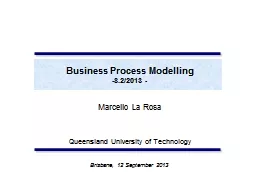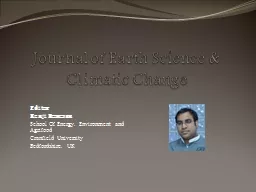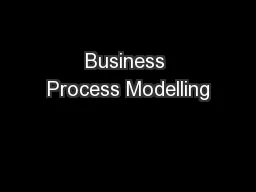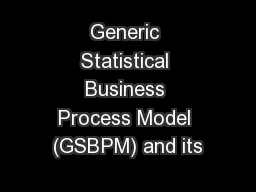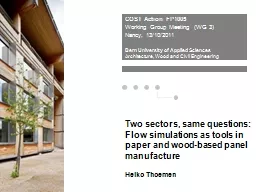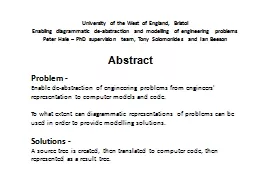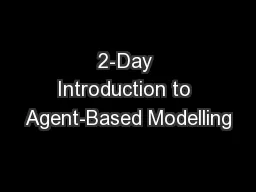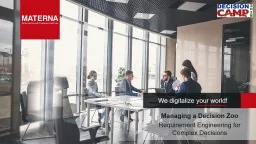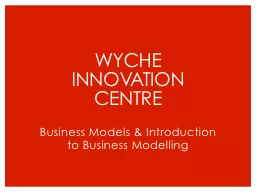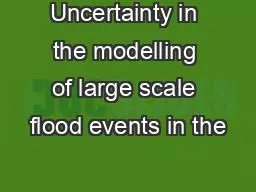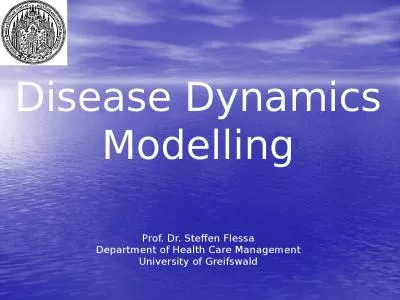PPT-Business Process Modelling
Author : stefany-barnette | Published Date : 2018-02-25
822013 Marcello La Rosa Queensland University of Technology Brisbane 12 September 2013 Midsemester survey your words our actions Generally very positive comments
Presentation Embed Code
Download Presentation
Download Presentation The PPT/PDF document "Business Process Modelling" is the property of its rightful owner. Permission is granted to download and print the materials on this website for personal, non-commercial use only, and to display it on your personal computer provided you do not modify the materials and that you retain all copyright notices contained in the materials. By downloading content from our website, you accept the terms of this agreement.
Business Process Modelling: Transcript
822013 Marcello La Rosa Queensland University of Technology Brisbane 12 September 2013 Midsemester survey your words our actions Generally very positive comments A few notes worth commenting. -10.2/2013 -. Marcello La Rosa. Queensland University of Technology. Brisbane, . 26 September 2013. Quick Repeat from Week 9. How can we compensate for the effects of an activity?. How can we perform routines in parallel to a process?. Editor. Renji. . Remesan. School Of . Energy, Environment and . Agrifood. Cranfield. University. Bedfordshire. , UK. Biography. Renji. holds a basic degree in Agriculture Engineering from Kerala Agricultural University, India. . Pipeline . Qra. Seminar. Pipeline risk assessment . Software for consequence modelling. 2. What is consequence modelling?. Effects from accident (e.g. release or explosion). Strict physical effect (e.g. overpressure from explosion, flow from release and concentration at distance). -. 11.2/2013 . -. Marcello La Rosa. Queensland University of Technology. Brisbane, . 10 October 2013. Assignment 1 Results. Assignment 1 – Common mistakes. Models:. Generally, good to high-quality models, but. Experiences from the Australian Bureau of Statistics (ABS). Trevor Sutton. 1. Outline. “Industrialisation” and the need for a strategic focus on statistical business processes. Introduction to GSBPM as a reference model . of. Applied . Sciences. Architecture. , Wood . and. . Civil. Engineering. COST Action FP1005. Working Group Meeting (WG 3). Nancy, 13/10/2011. Two sectors, same questions: . Flow simulations as tools in paper and wood-based panel manufacture. Enabling diagrammatic de-abstraction and modelling of engineering problems. Peter Hale – PhD supervision team, Tony . Solomonides. and Ian Beeson. Abstract. Problem. -. Enable de-abstraction of engineering problems from engineers' representation to computer models and code. A/Professor Marcello La Rosa. Academic Director (corporate programs and partnerships) for IS School. PhD in BPM. Over 60 refereed publications. Instructor in numerous BPM training seminars in Australia. 3.5. Demonstrate understanding of how technological modelling supports technological development. Aims for this session. To share key messages for technological modelling level 3. T. o develop understanding of how . Day 2. :. Session 7. Social Science, Different Purposes and Changing Networks. Discussion: the . Social Science view of ABM. 2-Day Introduction to Agent-Based Modelling, Manchester, Feb/Mar 2013, slide . Agenda. About us. Introduction. Method. Decision Logic. Testing. 2. Message. Motivation. Report on a comple. x,. real-world decision project . and share the lessons learned with yo. u.. 3. Orlando, . Learning Objectives. Understand the difference between common business models. Compare and contrast common business models when applied to a business. Business Models. A business models is the system that transforms intangible business ideas into products/services that have value in the market place (Hedman and Kalling, 2003). Barotse. floodplain, Zambia. . Tom Willis. 1. , Mark Smith. 1. , Donall Cross. 2. , Andrew Hardy. 3. , Georgina Ettritch. 3. , Happiness Malawo. 4. , . Mweemba. Sinkombo. 4. , Cosmas Chalo. 4. , Elizabeth Mroz. Prof. Dr. . Steffen Flessa. Department of Health Care Management. University of Greifswald. Population: 82,000,000. Prof. Dr. Steffen Fleßa. 1966. Married, 2 children. BA, MBA, . PhD, .
Download Document
Here is the link to download the presentation.
"Business Process Modelling"The content belongs to its owner. You may download and print it for personal use, without modification, and keep all copyright notices. By downloading, you agree to these terms.
Related Documents

